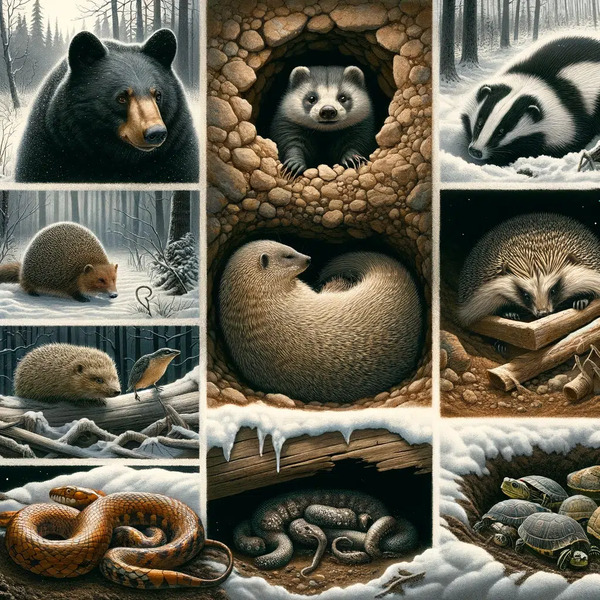Hibernation is an adaptation to cold climates and food shortages, and many animals hibernate to survive adverse winter conditions. Here are some animals that need to hibernate and their hibernation habits:

Bear
Species: such as brown bear, black bear, grizzly bear.
Habits: Bears enter a hibernation-like state during the winter called winter dormancy. Their body temperatures decrease, but not as dramatically as in true hibernators. Bears do not eat, drink or eliminate during winter hibernation.
Species: such as little brown bat and big brown bat.
Habits: Bats enter a true state of hibernation in winter. Their body temperature drops significantly and their metabolic rate slows down to save energy. They gather in caves or buildings to spend the winter.
Hedgehog
Habits: Hedgehogs hibernate in winter, their body temperature drops to close to ambient temperature, and their heart rate and breathing rate slow down. They store fat to provide energy before hibernating.
Squirrel
Species: Such as ground squirrels.
Habits: Ground squirrels hibernate during the winter, while tree squirrels store food for the winter. Hibernating squirrels experience significant decreases in body temperature, heart rate and metabolic rate.
Groundhog
Habits: Marmots are typical hibernating animals. In winter, their body temperature drops, their heart rate and metabolic rate slow down, and they rely on stored fat to survive the cold winter.
Snake
Habits: Many snakes enter a hibernation-like state called torpor during the winter. Their metabolic rates slow down and they retreat into caves or burrows to escape the cold.
Turtle
Habits: Some turtles, such as box turtles and mud turtles, hibernate during the winter, causing their body temperatures to drop and their metabolic rates to slow. They spend the winter buried in dirt or sand.
Lizard
Habits: Some lizards enter a state of slumber in winter, their body temperature and metabolic rate drop, and they hide in burrows or rock crevices.
Habits: Many frogs hibernate during the winter. They will be buried in the soil or hidden at the bottom of the pond, and their body temperature and metabolic rate will drop significantly.
Salamander
Habits: Salamanders hibernate in winter, hiding in moist soil or humus to survive the cold winter.
Carp
Habits: Carp enters a state similar to hibernation in winter, called cryogenic dormancy. Their metabolic rate slows, their activity decreases, and they stay underwater to conserve energy.
Ladybug
Habits: Ladybugs enter a dormant state called diapause during the winter, hiding in tree bark, rock crevices or buildings to survive the cold season.
Butterfly
Species: Such as the monarch butterfly.
Habits: Some butterflies enter a state of diapause in winter, hanging on trees or other shelters, waiting for the arrival of spring.
Hibernation is a complex physiological adaptation by which many animals survive the cold and food-poor winter months. Examples of hibernation occur in mammals, reptiles, amphibians, fish, and insects. During hibernation, these animals' body temperature, heart rate, and metabolic rate drop significantly to conserve energy and rely on stored fat or other resources in the body to survive the winter.
animal tags: Hibernating-animals
We created this article in conjunction with AI technology, then made sure it was fact-checked and edited by a Animals Top editor.